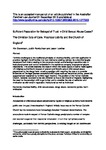Reparation for Betrayal of Trust in Child Sexual Abuse Cases: The Christian Duty of Care, Vicarious Liability and the Church of England
| dc.contributor.author | Stevenson, Kim | |
| dc.contributor.author | Rowbotham, J | |
| dc.contributor.author | Lowther, Jason | |
| dc.date.accessioned | 2016-05-04T14:45:33Z | |
| dc.date.accessioned | 2016-05-04T14:46:37Z | |
| dc.date.available | 2016-05-04T14:45:33Z | |
| dc.date.available | 2016-05-04T14:46:37Z | |
| dc.date.issued | 2015-12-31 | |
| dc.identifier.issn | 1320-0968 | |
| dc.identifier.issn | 2204-0064 | |
| dc.identifier.uri | http://hdl.handle.net/10026.1/4574 | |
| dc.description.abstract |
Feminist challenges to the traditional principles of vicarious liability highlight the difficulties facing claimants seeking redress via a doctrine largely developed in relation to the corporate model reflecting masculine traits of institutional power and control embedded in the traditional enterprise employer/employee relationship. This article explores the ways in which the recent spate of claims made against UK religious authorities regarding present and historic acts of child sexual abuse perpetrated by clergy have forced a paradigm shift requiring the courts to consider influences on the legal process associated with tropes of restorative justice, powerfully supported and explained by feminist legal theorists. The position of the Roman Catholic Church, however, is shown to be very different to that of the Church of England, highlighting the need for the paradigm shift to develop further and to consider the role of validation and vindication as elements in reparation, institutional as well as individual. | |
| dc.format.extent | 253-270 | |
| dc.language | en | |
| dc.language.iso | en | |
| dc.publisher | Taylor and Francis | |
| dc.relation.replaces | http://hdl.handle.net/10026.1/4573 | |
| dc.relation.replaces | 10026.1/4573 | |
| dc.subject | Child sexual abuse | |
| dc.subject | Clergy abuse | |
| dc.subject | Reparation | |
| dc.subject | Feminist tort theory | |
| dc.title | Reparation for Betrayal of Trust in Child Sexual Abuse Cases: The Christian Duty of Care, Vicarious Liability and the Church of England | |
| dc.type | journal-article | |
| dc.type | Article | |
| plymouth.issue | 2 | |
| plymouth.volume | 41 | |
| plymouth.publication-status | Published | |
| plymouth.journal | Australian Feminist Law Journal | |
| dc.identifier.doi | 10.1080/13200968.2015.1077553 | |
| plymouth.organisational-group | /Plymouth | |
| plymouth.organisational-group | /Plymouth/Faculty of Arts, Humanities and Business | |
| plymouth.organisational-group | /Plymouth/REF 2021 Researchers by UoA | |
| plymouth.organisational-group | /Plymouth/REF 2021 Researchers by UoA/UoA18 Law | |
| plymouth.organisational-group | /Plymouth/Research Groups | |
| plymouth.organisational-group | /Plymouth/Research Groups/Marine Institute | |
| plymouth.organisational-group | /Plymouth/Users by role | |
| plymouth.organisational-group | /Plymouth/Users by role/Academics | |
| dcterms.dateAccepted | 2015-07-16 | |
| dc.rights.embargodate | 2015-12-31 | |
| dc.identifier.eissn | 2204-0064 | |
| dc.rights.embargoperiod | Not known | |
| rioxxterms.versionofrecord | 10.1080/13200968.2015.1077553 | |
| rioxxterms.licenseref.uri | http://www.rioxx.net/licenses/all-rights-reserved | |
| rioxxterms.licenseref.startdate | 2015-12-31 | |
| rioxxterms.type | Journal Article/Review | |
| plymouth.oa-location | http://www.tandfonline.com/doi/full/10.1080/13200968.2015.1077553 |


